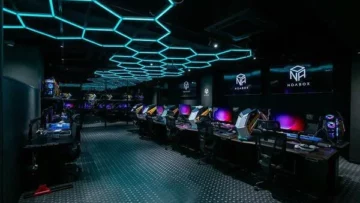What is Esports? Explaining the System, History, and Popular Games

Index
- What is esports?
- Structure of esports
- Market Size of esports
- History of esports
- Features of esports
- List of esports Game Types and Genres
- 5 Steps for Streaming Beginners to Challenge esports
- STEP 1: Decide on Your Strongest Game Genre
- STEP 2: Set Up Your Streaming Environment and Build a Streaming Habit
- STEP 3: Join a Team or Community to Sharpen Your Skills
- STEP 4: Challenge Yourself in Amateur Tournaments or Events
- STEP 5: Continuously Share Your Achievements on Social Media and Streaming
- Major Professional Teams in esports
- Conclusion
The term “esports” has been frequently heard in recent times. Although it is often seen on television and in the news, there may be many people who do not fully understand what esports actually is.
This article will thoroughly explain the official name and definition of esports, the differences from gaming, the history in the world and Japan, as well as the tournament formats and rules regarding wins and losses.
If you’re looking to grasp the basics of esports or feel inclined to challenge yourself, please refer to this article.
What is esports?
First, let’s organize the fundamental concepts of esports. Understanding the origin of its name and its essential meaning will shed light on why it has garnered such global attention.
Official Name of esports
Esports is an abbreviation of “Electronic Sports,” which means “sports conducted using electronic devices.”
In Japan, it is often written as “eスポーツ,” but internationally, the lowercase “esports” is mainstream. It is capitalized to “Esports” only when it appears at the beginning of a sentence.
Interestingly, there is also the term “電子競技” (denki-kyōgi), but it is rarely used.
Meaning of esports
So, what does esports mean? Simply put, it refers to “competitive activities using digital games.” Similar to chess or shogi, competitors challenge each other under established rules using skill and strategy.
What is crucial here is the distinction between “just playing” and “competing.” There are both individual and team competitions, and at a global scale, there are sometimes significant prize pools. In other words, it is a formal competitive field that demands high skills and deep strategic thinking.
Definition of esports
According to the “New European Sports Charter,” sports are defined as “physical activities aimed at improving physical strength, achieving mental satisfaction, connecting with others, and enhancing performance.”
While esports does not involve intense physical exercise, it shares common ground with traditional sports in terms of the competitive spirit, mental achievements, and the community building aspect with peers.
Hence, the movement to officially recognize it as a “new form of sport” is spreading across various countries around the world.
Difference between esports and gaming
Many people tend to confuse general gaming with esports, but there are distinct differences. The biggest disparities lie in “systematization as a competition” and “creation of spectator value.”
Regular gaming is primarily for self-enjoyment, whereas esports entails fair rule-setting, organized tournament systems, and viewing environments enhanced by commentary and analysis.
Additionally, because competitive balance and entertainment value during viewing are taken into account, the titles appropriate for esports are limited.
Structure of esports
Let’s take a look at how esports is actually organized, including how tournaments are conducted and how wins and losses are determined. Understanding the structure will make watching even more enjoyable.
Tournament formats
The tournaments in esports come in various formats based on the number of participants and the nature of the competition. Here are some representative patterns.
Tournament style
Tournament style is a progression method adopted by many esports competitions. The flow can change drastically based on the results of wins and losses, meaning that a player’s mental state and decision-making directly influence outcomes. For spectators, it is exciting to follow the clashes between skilled teams as the brackets advance, creating an engaging format for broadcasts.
Moreover, the way tournaments are implemented can frequently vary by game title, leading to various types of tournament formats as listed below.
| Format | Overview | Characteristics | Commonly Adopted Game Genres |
|---|---|---|---|
| Single Elimination | A one-match knockout format where losing ends the tournament. Only the winner advances. | Quick determination of a winner | ・MOBA ・Fighting Games |
| Double Elimination | A format where players remain in the tournament until they lose twice, navigating between the winner and loser brackets. | ・Guarantees at least 2 matches ・Skilled players are less likely to drop out early | Fighting Games |
| Swiss Draw | All participants play the same number of matches, with opponents changing depending on results. | ・Everyone gets to compete equally ・Likely to face opponents of similar skill levels | Card Games (TCG/DCG) |
*Bracket refers to the tournament matchup chart.
When watching tournaments, pay attention not only to the format but also to how the brackets are structured and how they progress, as this can enhance the enjoyment of strategy and match developments.
League play
In league play, participating teams or players face each other in a round-robin format. Rankings are determined by win rates, and in the case of ties, they are ranked based on point differentials or head-to-head results.
There are primarily two formats for league play:
- Single Round Robin: Teams play once against each other
- Double Round Robin: Teams play twice against each other
The advantage of league play is that all teams get equal opportunities to compete, and the true skill level is more likely to be reflected in the results. It’s common for leagues to follow a tournament format similar to the group stages of the FIFA World Cup, where top teams advance to knockout rounds.
Unlike tournament formats where a single match determines everything, league formats are valued for their ability to reflect players’ conditions and team strengths in a more comprehensive manner.
Team competition
Team competitions involve multiple players competing in formats such as 5 vs 5 or 3 vs 3. Not only individual strengths matter but also the order of team members impacts the results. While specific rules may vary by tournament, the commonality is that the outcomes of individual matches determine team results.
Here are three representative formats:
| Format | Mechanism | Characteristics |
|---|---|---|
| Knockout Match | Losers are replaced, and winners remain in the competition | If one player wins consecutively, a perfect score is possible |
| Star Battle | Same position players compete, and the result is settled by a set number of wins | Starting players compete one by one |
| Waseda Style | A hybrid of Star Battle and Knockout Match | The remaining players continue in a knockout format based on win/loss results |
Team competitions are engaging due to the clear changes in momentum, making them enjoyable even for first-time viewers.
Rules for Winning and Losing
The determination of wins and losses in esports is governed by unique rules established for each game. Below are specific examples:
- Fighting Games: The player who wins the first round wins
- FPS: The team achieving the most kills, inflicted damage, or completing specific objectives is declared the winner
In professional tournaments, it is common to combine multiple match formats from preliminaries to finals, determining the ultimate winner through the following flow:
1. League Play
2. Double Elimination
3. Finals
Matches are live streamed on platforms like Twitch and YouTube, with commentary and analysis clarifying the situations for viewers. This makes it easy for first-time watchers to follow the match developments. Observing the decisions and strategies of top players through gameplay can also contribute to your improvement as a player.
Market Size of esports
Esports has grown beyond a mere activity into a massive business market. As of 2019, the global market reached approximately $960 million*1, with projections estimating growth to $1.62 billion*1 by 2024.
The domestic market recorded 12.5 billion yen*2 in 2022 and is expected to approach 20 billion yen*2 by 2025. According to the “Japan eSports White Paper 2024” by the Japan eSports Union, the domestic market in 2023 grew by 17% from the previous year, reaching 14.685 billion yen, with nearly 40% of that attributed to event-related businesses.
This growth trend indicates that esports is establishing itself as a new pillar within the entertainment industry.
*1…Source: Ministry of Economy, Trade and Industry “Report on Promoting Content Overseas Expansion (Validation of Advertising Value in esports and Gaming Spaces among Generation Z)“
*2…Source: Japan eSports Union “Japan eSports White Paper 2024 / Kadokawa ASCII Research Institute“
History of esports
Understanding the origins of esports and its development will provide more insight into its current prosperity. Let’s follow the history in both the world and Japan.
World History
The origins of esports can be traced back to arcade game competitions in the 1970s and 1980s. In the United States, which is the birthplace of esports, about 10,000 people attended the national Space Invaders championship, gaining significant media attention.
With the spread of the internet in the 1990s, online competitions became possible, leading to an increase in tournaments.
In the early 2000s, South Korea launched pro leagues for “StarCraft,” while in the U.S., “Major League Gaming” was founded, marking the beginning of professional movements.
Since the 2010s, advancements in streaming technology and the entry of sponsor companies have made world championships with prize pools worth billions commonplace.
History in Japan
In Japan, it is said that Sega hosted a national tournament for home consoles in 1974, marking the beginning. The “Famicom National Caravan” by Nintendo in 1985 saw many children compete for skills.
Starting around 2003, fighting game tournaments like “Tougeki” gained attention, gradually familiarizing the concept of esports. In 2007, a preparatory organization for the Japan eSports Association (JESPA) was established, leading to efforts to promote tournaments nationally. Subsequently, the current Japan eSports Union (JeSU) was established in 2018 as a separate organization.
JeSU has contributed to the development of the domestic esports scene through the introduction of pro licensing systems and the management of official tournaments. Now, national tournaments between prefectures and industry award systems have been established, steadily enriching the competitive environment.
If you want to know more about the various esports game categories, please refer to the following article.
>>Comprehensive Overview of esports Types! Explaining Game Titles and Essential Skills
Features of esports
Esports is loved worldwide due to its unique charm that traditional sports do not offer. Here are four main points explaining its characteristics.
Minimal physical limitations, easy for anyone to start
The allure of esports lies in the fact that it does not require intense physical exertion. Anyone can participate regardless of age, physical fitness, or physical limitations. Although long periods of concentration are necessary, with proper health management, individuals from elementary school students to senior citizens can enjoy it.
Much like strategic sports such as chess or go, cognitive skills and judgment are key to winning. Individuals who use wheelchairs or have physical disabilities can also compete effectively thanks to customized controllers.
In traditional sports, physical ability differences often lead directly to outcomes, but in esports, tactical understanding and precise operational skills can level the playing field.
Technology and strategy determine wins and losses
To achieve victory in esports, players must possess not only swift operational skills but also deep strategic thinking. They must make optimal decisions and coordinate with team members within limited time and choices.
Building experience through multiple matches enhances concentration and analytical abilities, and logical thinking is cultivated through gaming. Top players practice for hours daily, honing instant situational judgment and precise operational skills.
Players also develop the capacity to read the quirks of their opponents or predict the flow of the match. Reflexes, along with psychological warfare and tactical maneuvering, also play significant roles in shaping the outcome. This high level of skill and strategy provides spectators with intellectual excitement.
Connecting with the world online
With an internet connection, one can challenge opponents on the other side of the planet, which is the essence of esports. Players worldwide compete, transcending borders and time zones, and international tournaments showcase thrilling matchups on a global scale.
These tournaments are streamed live online in real time, allowing spectators from anywhere in the world to enjoy watching. In popular title competitions, millions tune in simultaneously, and fans unite through social media and chat functionalities.
The comments section during streaming is filled with various languages, sharing a common excitement. It offers a unique sports experience of the digital era that feels free of physical distances, providing convenience as one can witness world-class skills from home.
Spectators can enjoy strategic thrills
Watching esports brings the unique thrill of gaining insight into players’ psychology and strategies.
Moments like “Now, unleash the special move!” or “There, it’s better to secure defense…” frequently get spectators riled up. The interactions and psychological battles between players come through the screen, providing an exhilarating sense of being part of the match.
List of esports Game Types and Genres
Esports encompasses a vast array of competitive categories, each with its unique appeal. Below are the main categories organized for your reference.
FPS
FPS (First Person Shooter) is a shooting game viewed from a first-person perspective. In the player’s view, mainly their hands and weapons are visible, allowing for an immersive gaming experience as if they are present in the game.
While reflexes and precise aiming skills are fundamental, teamwork plays a crucial role, requiring coordination and role division among squad members. Although beginners can easily understand the rules, substantial practice time is required to improve.
TPS
TPS (Third Person Shooter) is a shooting game viewed from a third-person perspective. It offers players a wider field of view compared to FPS.
Players can make more strategic judgments about their surroundings, employing tactics like hiding behind obstacles or predicting enemy movements. Therefore, success often hinges not only on basic shooting skills but also on advanced tactical insight and positioning.
Many titles involve building elements and special abilities, testing creativity in gameplay.
RTS
RTS (Real Time Strategy) is a real-time strategy game where players command armies or organizations to conquer enemy bases.
It requires simultaneous resource gathering, troop formation, enhancements, and timing of attacks in real time. High-level strategic planning and quick decision-making skills are essential.
The intellectual appeal lies in the ability to read opponents’ strategies and effectively deploy counters. Due to the high volume of controls, RTS is considered a genre suitable for advanced players.
MOBA
MOBA (Multiplayer Online Battle Arena) is an online combat game involving multiple players, typically structured into teams of five, each taking on different roles.
Unlike RTS, where one player commands everything, MOBA’s distinction lies in the balance between teamwork and individual skills determining the outcome. There are clear role distributions such as tanks, attackers, and support roles, making team coordination essential.
Fighting
Fighting games involve aiming to reduce an opponent’s health to zero in one-on-one matches. This genre reflects an individual’s skills most directly, necessitating reflex speed, combo techniques, and the ability to read opponents’ minds.
Exciting special moves and tense strategic plays catch the attention of spectators, as split-second decisions regarding whether to guard or dodge an attack or when to unleash a counterattack dictate the outcome.
With relatively short match times, fast-paced developments become an attractive aspect as well.
Sports
Digital sports games recreate real sports in a virtual space. With familiar sports such as soccer, baseball, and basketball as themes, this genre is accessible for esports beginners.
Strategies considering player abilities and team formations can dictate the outcomes. It is a genre that appeals to both real sports enthusiasts and gaming fans.
Puzzle
Puzzle games involve competing to solve puzzles faster and more efficiently than opponents. Their simple rules make them easy to understand and enjoyable for all ages.
The ability to make instantaneous strategic choices, whether to proceed carefully or to take risks for a larger chain, is crucial in determining who succeeds. Psychological battles also unfold as players time their attacks while observing opponents’ screens.
Racing
Racing games require players to steer vehicles using controllers, aiming for the fastest finish. Realistic graphics and engaging sound effects provide sensations akin to participating in a real race.
These games demand techniques and knowledge close to real motorsport, and it is not uncommon for professional drivers to compete. Subtle maneuvers, breaking points, and timing for overtakes can be the deciding factors for victory.
Music
In music games, players press buttons or move their bodies in sync with the rhythm of the songs to score points. Titles like “Taiko no Tatsujin” and “maimai,” familiar from arcades, exemplify this genre.
Compared to other esports categories, music games involve more physical actions, so stamina and reflexes become important. Higher difficulty songs may require incredibly rapid actions, leaving spectators in awe. The unique allure lies in the experience of competing while enjoying music.
DCG
DCG (Digital Card Game) refers to digitized card games. Similar to traditional paper card games, players build decks and engage in battles requiring meticulous strategies. The combinations of cards, timing for use, and insights into opponents’ psychology determine victory or defeat.
Unique features of digital versions—such as engaging effects and automated processing—allow for a quick-paced experience. The high degree of freedom in deck creation is also appealing, encouraging players to test their unique strategies.
5 Steps for Streaming Beginners to Challenge esports
If you’re thinking, “I want to start esports! But where should I begin?” we’ve outlined a step-by-step method to gradually level up while utilizing streaming.
STEP 1: Decide on Your Strongest Game Genre
The first step is to select a “game genre that you can enjoy for a long time.” Since esports encompasses a variety of competitions, find one that aligns with your interests and aptitudes.
Criteria for selection could include, “I already play and feel skilled at this,” “I can easily secure practice time,” and “it’s popular in tournaments or streams.” Also, consider how frequently tournaments are held for that genre and whether your personality suits team-based or individual competitions.
FPS games demand reflexes, while strategy games leverage analytical thinking. Begin by actually playing genres that catch your interest to see how well they match you.
STEP 2: Set Up Your Streaming Environment and Build a Streaming Habit
Streaming is an excellent tool for recording your growth and establishing connections within the community. Start by selecting platforms like Twitch or YouTube, and then prepare streaming software, audio equipment, and video facilities.
Check your internet connection stability and PC specifications, then configure your streaming setup using tools like OBS Studio. It’s also wise to establish branding elements like a channel name and icon.
By creating a regular streaming schedule, you deepen your relationship with viewers and lay the groundwork for future team involvement or tournament participation. For detailed settings related to streaming, refer to the following article.
>>OBS High-Quality Streaming: Best FPS Settings and Recommendations
If you’re unsure about selecting a streaming platform, please check the following article as well.
>>Best Streaming Platforms for Gamers: A Beginner’s Guide to Choosing & Features
STEP 3: Join a Team or Community to Sharpen Your Skills
Practicing alone is less effective than honing your skills with peers. Participate in Discord communities, in-game guilds, or fan clubs of streamers to connect with players who share your aspirations.
Regular practice sessions and friendly matches build combat experience, and observing advanced players can teach you techniques. Feedback from peers may reveal weaknesses you weren’t aware of or introduce you to new strategies. Most importantly, having teammates with similar goals can keep your motivation high.
STEP 4: Challenge Yourself in Amateur Tournaments or Events
Participating in online and local events, as well as amateur tournaments, is a valuable opportunity for “enhancing competition awareness,” “building achievements,” and “gaining experience.” Choose tournaments that match your skill level, and be sure to thoroughly confirm the entry methods and tournament formats before participating.
After the tournament, document your results and areas for improvement to define challenges for the next time. Regardless of the outcomes, the experience of “participating in a tournament” itself holds intrinsic value.
Actual tournaments will present unique tensions and pressures that differ from practice, strengthening your mental resilience.
Combine SNS platforms like X (formerly Twitter), Instagram, and TikTok with your streaming activities to engage in “brand building,” “growth recording,” and “fan base creation.”
Regularize your streaming and SNS posts, sharing your narrative in relatable forms. Visualizing your achievements with specifics like tournament participation counts, team history, streaming milestones, and follower counts through concrete numbers and screenshots is highly recommended. Engaging in proactive communication with your audience and followers will promote fandom.
Major Professional Teams in esports
Here are some top professional teams representing the Japanese esports scene. Understanding their origins and strengths will allow you to appreciate the depth of the esports industry.
AXIZ
AXIZ was launched in June 2018 as part of a new initiative by Nippon Television. The team name combines the call sign “AX” from Nippon TV and “axis,” aiming to be a pivotal presence in the esports scene.
They compete in titles such as “IdentityV,” “League of Legends,” and “Shadowverse.” Their notable achievements include reaching the top 8 in Call Of The Abyss VI (Identity V) and winning the RAGE SHADOWVERSE PRO TOUR 23-24 CHAMPIONSHIP (Shadowverse).
Crazy Raccoon
Crazy Raccoon is a multi-entertainment team established in April 2018. They are known for hosting the “CR Cup,” featuring prominent streamers such as Ryosuke Yamada and 3BR (Kisuke Yuta, SHAKA, SPYGEA), while managing esports teams alongside a diverse range of entertainment ventures.
They are active in games like “Apex Legends,” “Brawl Stars,” “Clash Royale,” “Fortnite,” and “Overwatch.” Prominent achievements include being the runner-up in the ALGS 2022 Split 2 Pro League – APAC North (Apex Legends) and reaching the top 4 in the Brawl Stars World Finals 2023.
Detonation FocusMe
Detonation FocusMe was founded in July 2012 as “DetonatioN” and transformed into Japan’s first fully-fledged pro gaming team in January 2015. Their League of Legends division began activities in 2013 and has since won 16 domestic official tournaments, boasting overwhelming strength with podium finishes in all events, including runner-up positions.
Their main active titles include VALORANT, LoL, Fortnite, and Super Smash Bros. Notable achievements are winning the LJL 2023 Summer (League of Legends) and Umebura SP3 (Super Smash Bros.).
FAV gaming
FAV gaming is a pro team established in March 2018. They gained attention by reuniting legendary members (sako, Ryusei, Tokido, Bonchan) who won the Street Fighter League Pro-JP 2021 for the upcoming 2023 competitions, successfully reclaiming the championship title.
They are active in titles like VALORANT, IdentityV, Super Smash Bros., and Street Fighter. Notable achievements include being runner-up in the Asia Pacific Predator League 2024 (VALORANT) and winning the Street Fighter League: Pro-JP 2023 (Street Fighter).
RIDDLE
RIDDLE was established in October 2016 as an amateur team by popular streamer “Bodka” and became a pro team in July 2020 after acquiring sponsorships. In February 2022, they welcomed the well-known local Apex team “456,” and the interactions with the owner continue to endear them to fans.
They compete in games like Apex Legends, Fortnite, and VALORANT. Notable achievements include winning the Apex Legends Global Series: Split 1 Playoffs – APAC North and FNCS: Season X – Grand Finals: Asia.
Conclusion
This article provided an accessible explanation of the definition, structure, history, popular genres, and market size of esports.
Esports is a competitive arena that anyone can easily enter, yet it demands high levels of strategy and skill, marking a new culture of sports. With tournaments and events flourishing nationally and internationally, further developments are expected.
For instance, the upcoming “Tokyo eSports Festival 2026” is set to announce the latest tournament and event details, so if you’re interested, be sure to check it out.








